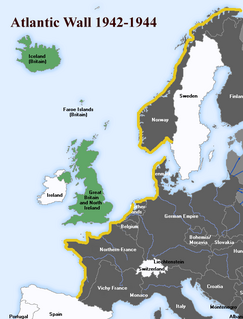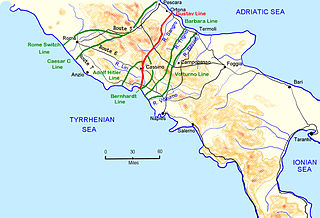 W
WThe Trasimene Line was a German defensive line during the Italian Campaign of World War II. It was sometimes known as the Albert Line. The German Commander-in-Chief (C-in-C), Generalfeldmarschall Albert Kesselring, used the line to delay the Allied northward advance in Italy in mid June 1944 to buy time to withdraw troops to the Gothic Line and finalise the preparation of its defenses.
 W
WThe Atlantic Wall was an extensive system of coastal defences and fortifications built by Nazi Germany between 1942 and 1944, along the coast of continental Europe and Scandinavia as a defence against an anticipated Allied invasion of Nazi-occupied Europe from the United Kingdom, during World War II. The manning and operation of the Atlantic Wall was administratively overseen by the German Army, with some support from Luftwaffe ground forces. The Kriegsmarine maintained a separate coastal defence network, organised into a number of sea defence zones.
 W
WDuring the Italian Campaign of World War II, the Barbara Line was a series of German military fortifications in Italy, some 10–20 mi (16–32 km) south of the Gustav Line, from Colli al Volturno to the Adriatic Coast in San Salvo and a similar distance north of the Volturno Line. Near the eastern coast, it ran along the line of the Trigno river. The line mostly consisted of fortified hilltop positions. The line was broken by the allied army in November 1943 following which the Axis forces withdrew to the defensible positions of the Winter Line.
 W
WThe Bernhardt Line was a German defensive line in Italy during the Italian Campaign of World War II. Having reached the Bernhardt Line at the start of December 1943, it took until mid-January 1944 for the U.S. Fifth Army to fight their way to the next line of defences, the Gustav Line. The line was defended by XIV Panzer Corps, part of the German Tenth Army.
 W
WThe Caesar Line was the last German line of defence in Italy before Rome during the Italian Campaign of the Second World War. It extended from the west coast near Ostia, over the Alban Hills south of Rome, from Valmontone to Avezzano and then to Pescara on the Adriatic coast. Behind the western half of the line was a subsidiary line, the Roman switch line which took a path north of Rome.
 W
WThe Hitler Line was a German defensive line in central Italy during the Second World War. The strong points of the line were at Aquino and Piedimonte. In May 1944, the line was renamed the Senger Line, after General von Senger und Etterlin, one of the generals commanding Axis forces in the area. This was done at Hitler's insistence, in order to minimise any propaganda significance should the line be penetrated.
 W
WThe Gothic Line was a German defensive line of the Italian Campaign of World War II. It formed Field Marshal Albert Kesselring's last major line of defence along the summits of the northern part of the Apennine Mountains during the fighting retreat of the German forces in Italy against the Allied Armies in Italy, commanded by General Sir Harold Alexander.
 W
WThe Winter Line was a series of German and Italian military fortifications in Italy, constructed during World War II by Organisation Todt and commanded by Albert Kesselring. The series of three lines was designed to defend a western section of Italy, focused around the town of Monte Cassino, through which ran the important Highway 6 which led uninterrupted to Rome. The primary Gustav Line ran across Italy from just north of where the Garigliano River flows into the Tyrrhenian Sea in the west, through the Apennine Mountains to the mouth of the Sangro River on the Adriatic coast in the east. The two subsidiary lines, the Bernhardt Line and the Hitler Line ran much shorter distances from the Tyrrehnian sea to just North East of Cassino where they would merge into the Gustav Line. Relative to the Gustav Line, the Hitler Line stood to the North-West and the Bernhardt Line to the South-East of the primary defenses.
 W
WThe Hitler Line was a German defensive line in central Italy during the Second World War. The strong points of the line were at Aquino and Piedimonte. In May 1944, the line was renamed the Senger Line, after General von Senger und Etterlin, one of the generals commanding Axis forces in the area. This was done at Hitler's insistence, in order to minimise any propaganda significance should the line be penetrated.
 W
WThe Kammhuber Line was the Allied name given to the German night air defense system established in July 1940 by Colonel Josef Kammhuber. It consisted of a series of control sectors equipped with radars and searchlights and an associated night fighter. Each sector would direct the night fighter into visual range with target bombers.
 W
WThe Panther–Wotan line was a defensive line partially built by the German Wehrmacht in 1943 on the Eastern Front. The first part of the name refers to the short northern section between Lake Peipus and the Baltic Sea at Narva. It stretched all the way south towards the Black Sea along the Dnieper.
 W
WThe Pomeranian Wall, Pomeranian Line or Pomeranian Position was a line of fortifications constructed by Nazi Germany in the Pomeranian Lakeland region. It was constructed in two phases. In the years 1930-1935 it was constructed as a light defensive position in case of an attack from the Second Polish Republic against the German republic. The line of fortifications stretched from Landsberg an der Warthe to Baldenburg and Pollnow (Polanów). The fortifications had several impressive strong points, particularly near Deutsch-Krone (Wałcz) and the 'Hangman Mountain'. The second phase took place during the Second World War, in 1944, when after a series of defeats on the Eastern Front the Pomeranian Wall was renovated in order to stop the Red Army advance. Various battles along the Pomeranian Wall took place particularly from January to March 1945, for example, the Battle of Kolberg, with the Red Army and units of the Polish People's Army eventually breaking through the wall in various places.
 W
WThe Roman switch line was a German line of defense during World War II in Italy branching off the Caesar C line and running north of Rome towards coast of the Tyrrhenian Sea. The next line was Trasimene Line in central Italy which was intended to delay the Allies and allow the completion of the Gothic Line a major defensive works north of Florence.
 W
WThe Hitler Line was a German defensive line in central Italy during the Second World War. The strong points of the line were at Aquino and Piedimonte. In May 1944, the line was renamed the Senger Line, after General von Senger und Etterlin, one of the generals commanding Axis forces in the area. This was done at Hitler's insistence, in order to minimise any propaganda significance should the line be penetrated.
 W
WThe Siegfried Line, known in German as the Westwall, was a German defensive line built during the 1930s opposite the French Maginot Line. It stretched more than 630 km (390 mi); from Kleve on the border with the Netherlands, along the western border of the old German Empire, to the town of Weil am Rhein on the border to Switzerland – and featured more than 18,000 bunkers, tunnels and tank traps.
 W
WThe Trasimene Line was a German defensive line during the Italian Campaign of World War II. It was sometimes known as the Albert Line. The German Commander-in-Chief (C-in-C), Generalfeldmarschall Albert Kesselring, used the line to delay the Allied northward advance in Italy in mid June 1944 to buy time to withdraw troops to the Gothic Line and finalise the preparation of its defenses.
 W
WThe Volturno Line was a German defensive position in Italy during the Italian Campaign of World War II.
 W
WThe Volturno Line was a German defensive position in Italy during the Italian Campaign of World War II.
 W
WThe Winter Line was a series of German and Italian military fortifications in Italy, constructed during World War II by Organisation Todt and commanded by Albert Kesselring. The series of three lines was designed to defend a western section of Italy, focused around the town of Monte Cassino, through which ran the important Highway 6 which led uninterrupted to Rome. The primary Gustav Line ran across Italy from just north of where the Garigliano River flows into the Tyrrhenian Sea in the west, through the Apennine Mountains to the mouth of the Sangro River on the Adriatic coast in the east. The two subsidiary lines, the Bernhardt Line and the Hitler Line ran much shorter distances from the Tyrrehnian sea to just North East of Cassino where they would merge into the Gustav Line. Relative to the Gustav Line, the Hitler Line stood to the North-West and the Bernhardt Line to the South-East of the primary defenses.